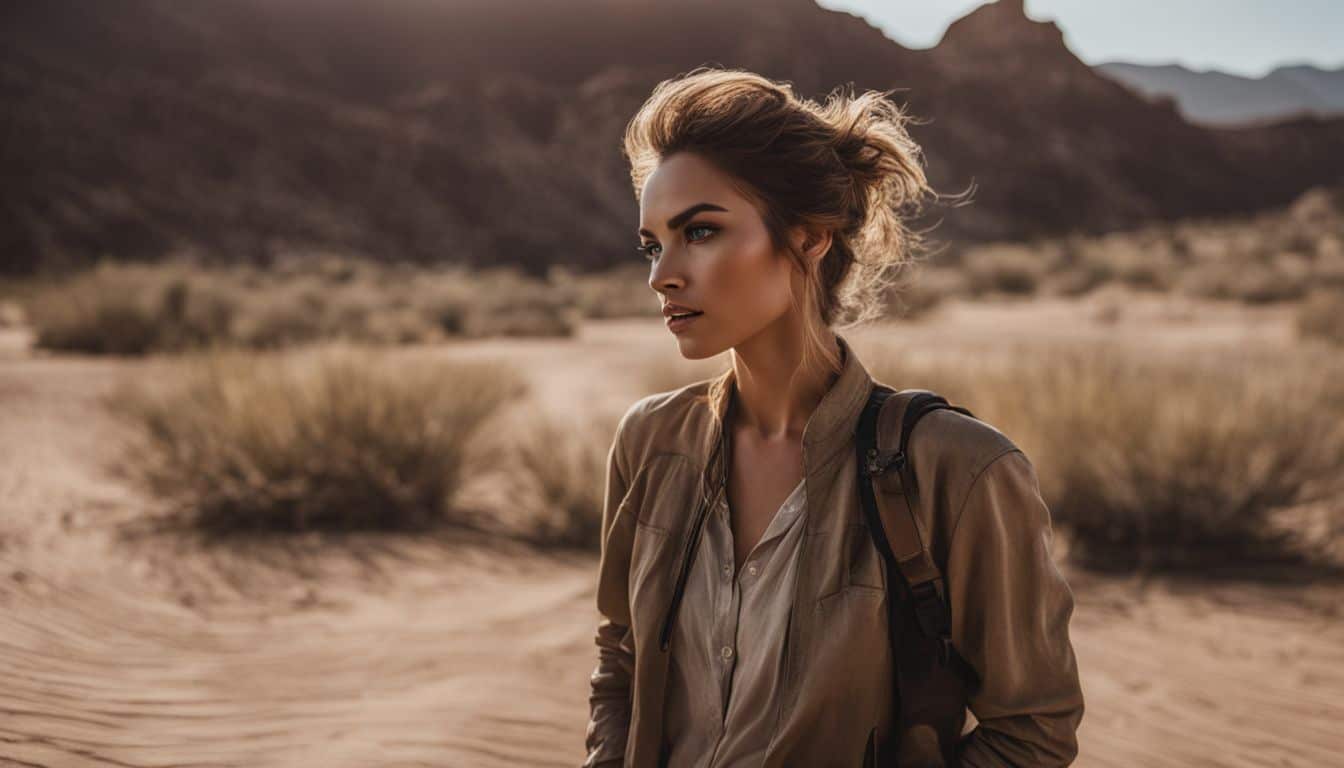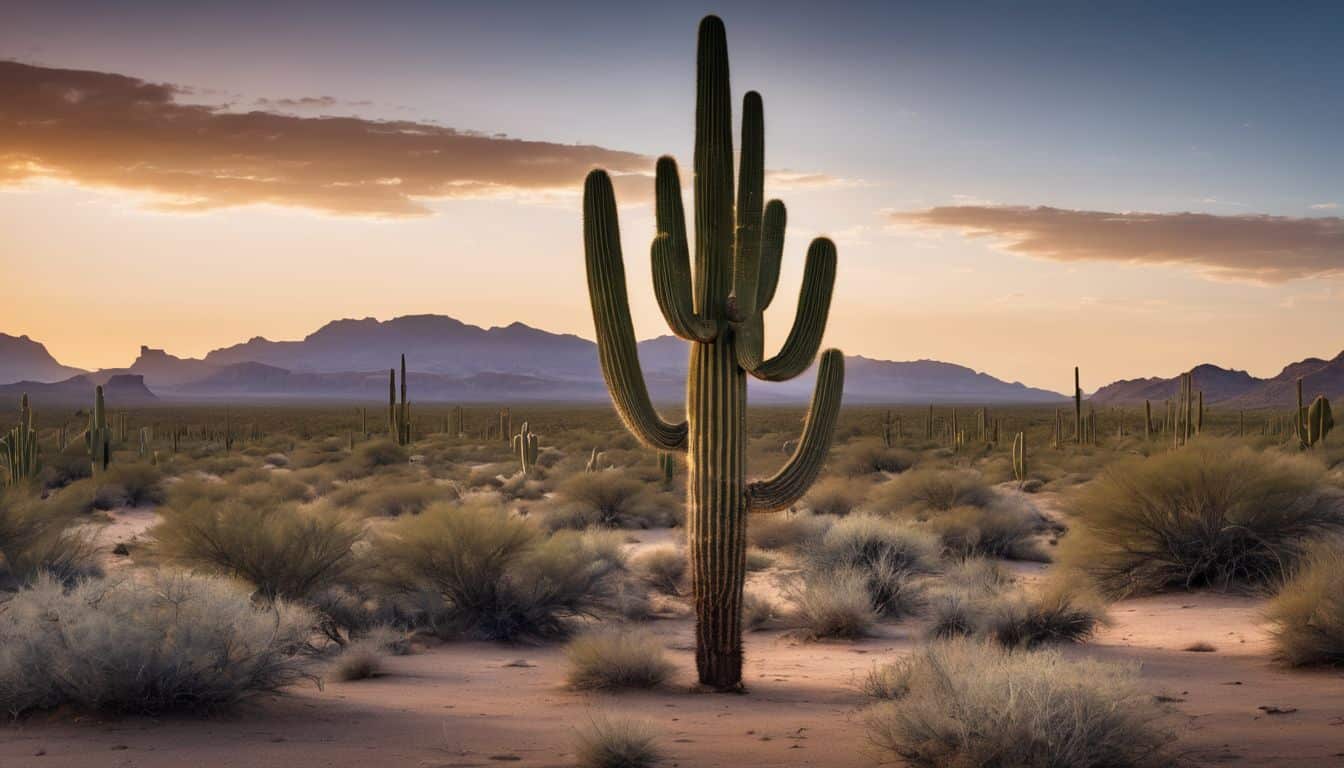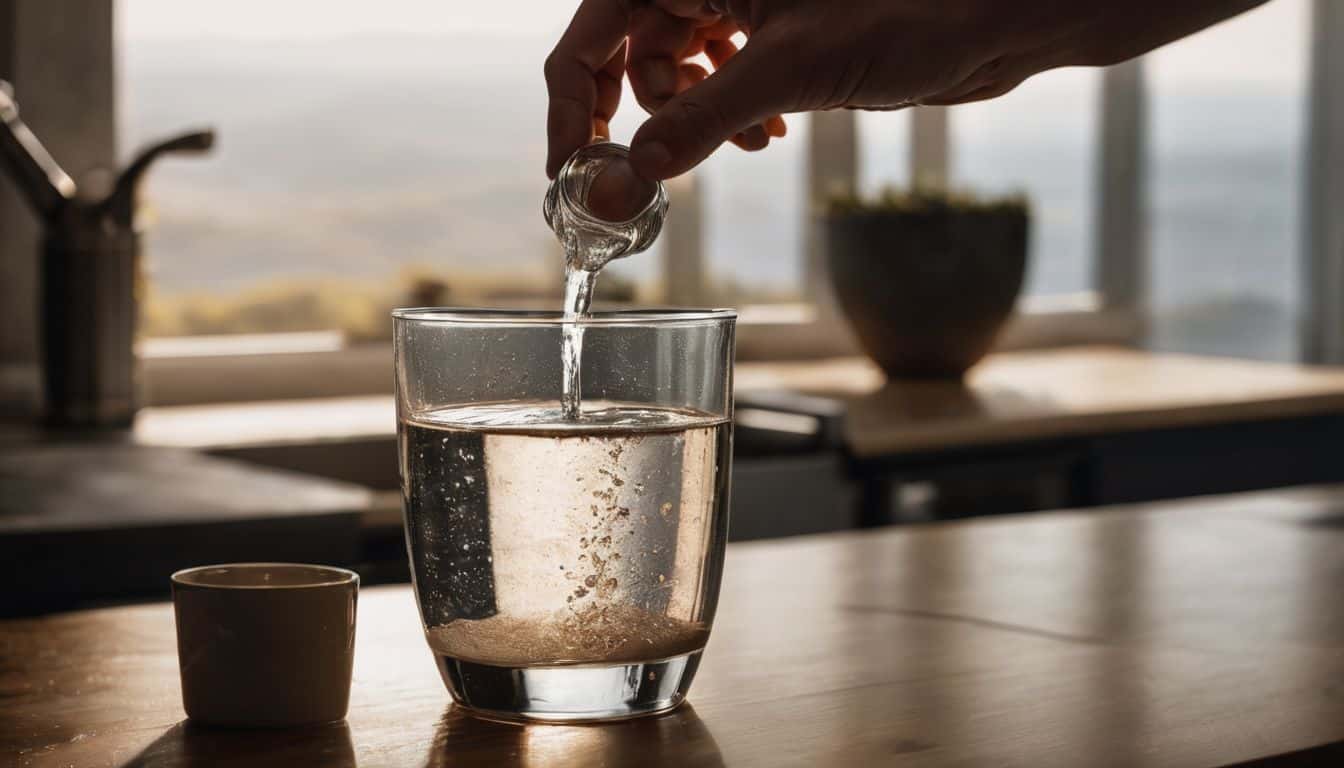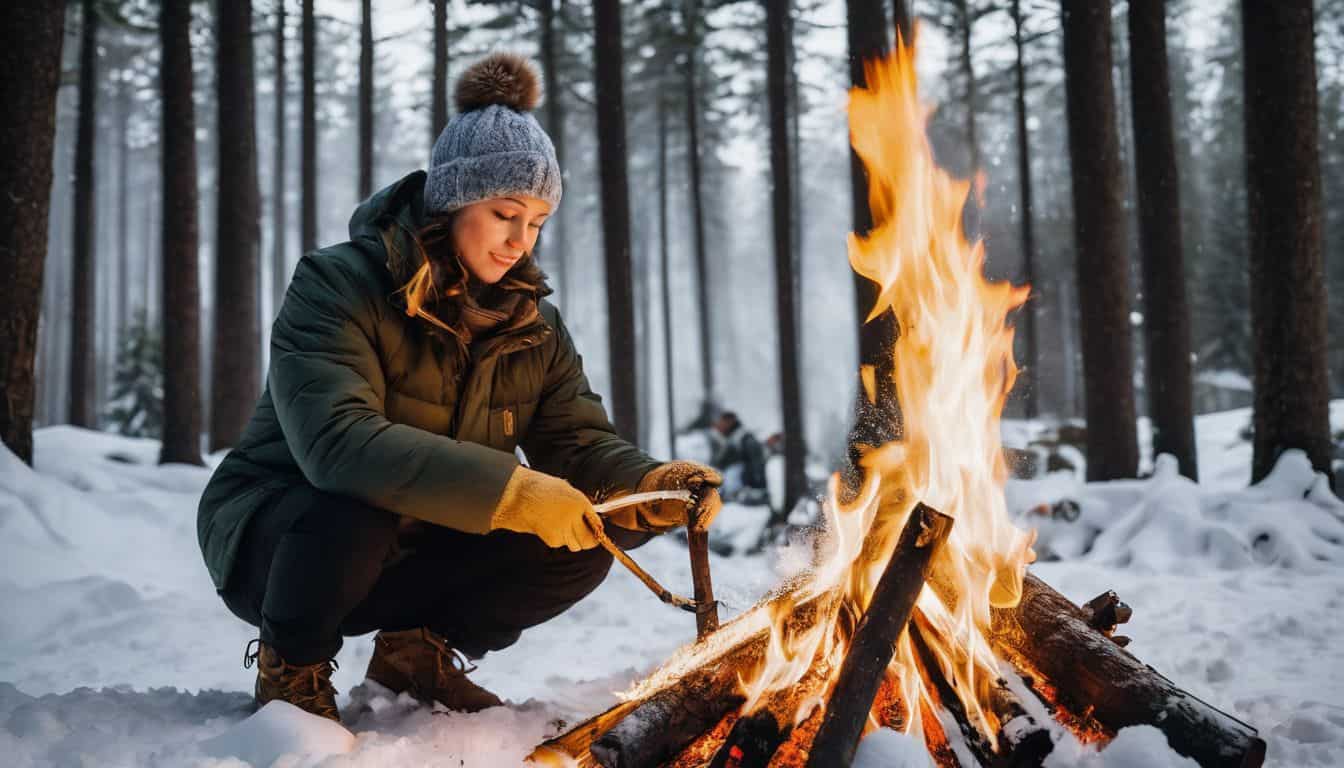Are you facing the challenge of living with a limited water supply? Trust me, I can relate. In fact, did you know that only 2% of Earth’s vast water resources are fresh and fit for consumption? After considerable research and my own share of trial-and-error experiences, I have found tricks to not just survive but thrive on minimal liquid resources.
And guess what? I’ve whittled it down to seven effective ways which will change how you view and use every precious drop! This blog post is all set to soak your curious mind into saving scarce water while ensuring a healthy lifestyle.
So stick around — together let’s uncover the surprising power hidden within each tiny droplet! Surviving on a limited water supply solutions!
Key Takeaways
- Only 2% of Earth’s water is fresh and fit for consumption.
- Water scarcity has severe impacts on the environment and communities.
- To survive on a limited water supply, turn off faucets when not in use. fix leaks promptly. reuse gray water for landscaping and gardening. use less water to wash dishes. only do full loads of laundry and dishes. consider water-efficient appliances and fixtures. and cover pools to reduce evaporation.
- Showers use less water than baths; keep sprinklers off when not necessary; turn off outdoor taps when not in use; fill up a jug of cold water in the fridge instead of running the tap until it gets cold.
Importance of Water Conservation
Water scarcity has severe impacts on our environment and communities, making sustainable water management crucial for our survival.
Impacts of water scarcity
Water scarcity hurts the world in many ways. It can wipe out wetlands. This is bad for birds, bugs, and plants that live there. Farms use lots of water. They often waste it too. This makes water shortage worse.
Climate change also adds to the problem of less water around us. Less rain falls from the sky because of this.
People fight over who gets to use water when it’s scarce. We all need clean drinking water to stay healthy and alive but some people can’t get any at all! Not having enough clean water also means we can’t wash our hands well.
It’s hard for countries to make money if they don’t have enough good clean water around them.
In short, not having enough good clean water makes life difficult for people, animals, and even our lands!
Need for sustainable water management
We all need water to live. But water is not always easy to get. We must use it in a smart way. This means we have to manage our water well. Managing water the right way helps us have enough even if there isn’t much around.
Some places don’t get lots of rain. Others may be too hot and dry for long times. This can make finding fresh water hard in these areas. Using less water and capturing the little that does fall from the sky helps these places survive on what they have.
It’s also good for our earth when we use just what we need, no more or less. We waste less this way, so there’s more left over for other things that need it like plants and animals.
Lastly, managing our water wisely saves money too! The less we waste now, the more we save later on things like bills and fixing broken pipes or taps. Being careful with how much we use today could mean a lot tomorrow – both for us people and our planet as well.
Understanding the Basics of Surviving on a Limited Water Supply
Water is gold when you have less of it. We use water for a lot of things every day. We drink it. We cook with it. Dishes get clean with water, and so do we! So how can we live when there’s not much to go around? First, the easy stuff has to come first.
Drinking keeps us alive and well, so that is number one.
Next on our list is cooking food and cleaning up after meals because hungry bellies need food too! It’s important to learn where you can find more water if needed. Streams or wells could be helpful in times like this.
Also, always think about ways other people can help save water too in your neighborhood or town! For example, arranging days when we all wash clothes together will save tons of gallons compared with us doing it alone at home daily.
It might seem small but believe me; those little drops saved by everyone will soon fill the ocean!
7 Ways to Conserve Water at Home
Don’t let faucets run; fix water leaks; reuse gray water for landscaping and gardening; use less water to wash dishes; only do full loads of laundry and dishes; consider water-efficient appliances and fixtures; cover pools to reduce evaporation.
Don’t let faucets run
I always make sure to turn off the tap while I’m not using it. Leaving faucets running longer than necessary is a common way people waste water. Running the faucet for extended periods of time can lead to significant water wastage, and that’s something we want to avoid.
Instead, when I’m cleaning vegetables, I rinse them in a stoppered sink or a pan of clean water instead of letting the faucet run while cleaning them. It’s a small change that can make a big difference in conserving water.
And by listening for dripping faucets and fixing leaks promptly, I can save even more water.
Fix water leaks
Fixing water leaks is essential for conserving water and surviving on a limited supply. Even small household leaks can waste gallons of water every day, so it’s important to check for and fix any leaks.
By regularly inspecting plumbing fixtures and indoor appliances that use water, you can prevent unnecessary wastage. Leaks in homes can result in the loss of more than 10% of water, which is why taking the time to check for and repair them is crucial.
Simple steps like using hose washers at spigots and hose connections can help eliminate leaks and save water. So remember, fixing those leaks not only helps conserve water but also ensures you have enough supply to survive.
Reuse gray water for landscaping and gardening
I love finding creative ways to conserve water, and one of my favorite methods is reusing gray water for landscaping and gardening. Did you know that up to 50% of a property’s water needs for landscaping can be met by using gray water? It’s true! Recycling gray water not only saves fresh potable water for other uses but also reduces overall water consumption.
Plus, collecting and utilizing gray water can help keep our plants hydrated while reducing unnecessary waste. Whether it’s watering vegetable plants, fruit trees, or flowers in the garden, reusing gray water is a sustainable and effective way to conserve this precious resource.
So why not give it a try? Let’s protect the environment while keeping our gardens thriving!
Use less water to wash dishes
When it comes to conserving water while washing dishes, there are a few key things you can do. One simple way is to use a dishpan filled with soapy water instead of letting the faucet run while you scrub dishes.
This helps to minimize water waste. Another tip is to quickly rinse the dishes with clean water instead of letting it continuously flow. Additionally, collecting the rinse water from dishes and food preparation can be reused for soaking other dirty items.
Pre-rinsing your dishes before washing them can also help ensure they get cleaned properly without using excessive amounts of water. Lastly, using a double sink and filling one side with soapy water and the other side with clean water allows for even more efficient dishwashing.
Only do full loads of laundry and dishes
When it comes to conserving water at home, one simple and effective tip is to only do full loads of laundry and dishes. Running a washing machine or dishwasher with a full load can save a significant amount of water.
In fact, resisting the urge to run a laundry load when there are only a few dirty items can save up to 3,400 gallons of water! Soaking dishes in collected rinse water instead of using running water also helps save both water and effort.
By adopting this practice, you can maximize your laundry and dish loads while efficiently using water in your daily cleaning routines.

Consider water-efficient appliances and fixtures
Water-efficient appliances and fixtures are an essential part of conserving water at home. By upgrading to efficient plumbing fixtures, such as low-flow toilets and water-saving faucets, you can save a significant amount of water.
In fact, new toilets alone can save five gallons or more with each flush! Look for products labeled with WaterSense, as they are specifically designed to help save both water and energy.
Homes that have high-efficiency plumbing fixtures and appliances can reduce their indoor water use by about 30%. So when it comes to conserving water, considering these water-efficient options is definitely a smart choice.
Cover pools to reduce evaporation
One effective way to conserve water at home is by covering pools to reduce evaporation. Evaporation is the largest source of energy loss for pools, and it can cause a significant amount of water to be lost each week.
By using a pool cover, you can prevent up to 94% of water loss due to evaporation. In fact, using a pool cover can save an average of over 24,000 gallons of water per year! Not only does this help conserve our limited water supply, but it also reduces the need for additional chemicals and maintenance.
So if you have a swimming pool, consider investing in a pool cover to minimize evaporation and do your part in conserving water.
Outdoor Water Conservation Tips
Switch to showers instead of baths to save water. Keep sprinklers off when not necessary and limit the use of outdoor faucets. Fix any leaks in your outdoor water systems to reduce your water footprint.
Install low-flow aerators on outdoor taps and fill up a jug of cold water in the fridge instead of running the tap until it gets cold.
Switch to showers
Switching to showers is a great way to save water. Showers use less water compared to baths. While baths can use up to 70 gallons of water, showers typically use only 10 to 25 gallons.
By taking shorter showers or pausing the water flow while lathering, you can save even more water – about 3 to 6 gallons per minute! Using water-saving shower heads or flow restrictors is another smart idea.
So, if you want to conserve water and be more eco-friendly, switch to showers and make a difference!
Keep sprinklers off
When it comes to conserving water outdoors, one simple way is to keep sprinklers off. Instead of relying on artificial watering systems, let nature do the work for you. This is especially effective during rainy days when Mother Nature provides natural irrigation.
By avoiding unnecessary use of sprinklers, we can save a significant amount of water and contribute to conserving our limited water supply. Not only does this help us survive with less water, but it also ensures that we are doing our part in preserving the environment and maintaining local water quality.
So remember, by keeping those sprinklers off and embracing nature’s hand, we can make a big difference in conserving water outdoors.
Turn off the tap
One of the simplest and most effective ways to conserve water outdoors is to turn off the tap when it’s not in use. When you’re doing activities like gardening, washing your car, or filling up a bucket, make sure to turn off the tap as soon as you’re done.
By doing this, you can save up to 10 gallons of water per person! It may seem like a small action, but every drop counts when it comes to water conservation. So let’s get into the habit of turning off the tap and do our part in preserving this precious resource for future generations.
Fill up the washing up bowl
When it’s time to do the dishes, I always make sure to fill up the washing up bowl. It’s a simple yet effective way to conserve water. By filling up the bowl with soapy water, I can wash all my dishes without letting the tap run continuously.
This helps me avoid wasting unnecessary water and saves gallons of precious resource each day. Plus, using a washing up bowl is not only practical but also efficient in surviving on a limited water supply.
So whenever you’re doing the dishes, remember to fill up that washing up bowl and be part of the effort to conserve water!
Fix leaks to reduce water footprint
Fixing leaks is an easy and effective way to reduce your water footprint when it comes to outdoor water conservation. Leaks are a common source of water leakage, especially in toilets.
By repairing any leaks under sinks or drips in taps, you can significantly reduce the amount of water wasted. Using hose washers at spigots and hose connections can also help eliminate leaks.
Fixing leaky faucets and toilets is one of the top ten water-saving tips, so it’s definitely worth taking the time to check for and fix any leaks around your home. It’s a simple step that can have a big impact on conserving water and protecting our environment.
Install low flow aerators on taps and showers
To conserve water in outdoor settings, it’s important to install low-flow aerators on taps and showers. These devices help reduce water consumption by using less than 2.5 gallons per minute.
By replacing old and inefficient faucets with WaterSense labeled models, you can save up to 700 gallons of water each year. Not only do low flow aerators help preserve our precious water resources, but they can also lower your monthly water and sewer bills.
Retrofitting your household faucets with these watersaving devices is a simple yet effective way to contribute to water conservation efforts.
Fill up a jug of cold water
One way to conserve water outdoors is to fill up a jug of cold water. This simple tip can help reduce your water usage and ensure that you have an extra supply on hand when needed.
By keeping a jug in the fridge, you can have cold drinking water without running the tap and wasting unnecessary amounts of water. It’s a small but effective step towards saving water and being more mindful of our limited resources.
Only fill the kettle as much as needed
When using a kettle, it’s important to only fill it with the amount of water that you actually need. This simple action can help conserve both water and energy. Many kettles have indicators or markings on the side to show how much water is needed for each use.
By filling the kettle just enough for your needs, you can reduce unnecessary wastage and contribute towards sustainable water usage. It’s also worth noting that during hosepipe bans or periods of limited water supply, this practice becomes even more crucial in conserving precious resources.
So remember, next time you boil the kettle, be mindful of only filling it as much as needed!
Additional Tips for Water Conservation
Check for plumbing leaks regularly to ensure that water is not being wasted unnoticed. Use leftover cooking water to water plants or clean dirty dishes. Fill up a jug of cold water in the fridge instead of running the tap every time you need a drink.
Check for plumbing leaks regularly
Regularly checking for plumbing leaks is an important water conservation tip that can help you survive on a limited water supply. Leaks in your pipes, faucets, hoses, and couplings can waste a significant amount of water both inside and outside your home.
By checking for leaks, you can ensure that water is not being wasted unnecessarily. Toilets are the most common source of water leakage, so it’s essential to check them as well. Remember that homes can waste more than 10% of their water due to leaks, so it’s crucial to regularly inspect indoor appliances and devices for any signs of leakage.
By taking these precautions and promptly fixing any leaks you find, you’ll be able to conserve precious water resources effectively.
Use leftover cooking water
I love finding ways to save water in the kitchen, and one simple method is to use leftover cooking water. Instead of pouring it down the drain, I like to recycle it for other purposes.
For example, I can use the water from boiling vegetables or pasta to water my plants or as a base for soups and sauces. It’s an easy way to reduce water consumption while cooking and be more environmentally friendly in my kitchen practices.
Fill up a jug of cold water in the fridge
I always make sure to fill up a jug of cold water in the fridge. Not only does it give me access to cold drinks whenever I need them, but it also helps conserve water. Instead of running the tap and wasting water while waiting for it to cool down, I have a ready supply of cool water right in my fridge.
It’s a simple way to save water without sacrificing convenience. Plus, by having cold water readily available, I can satisfy my thirst without using extra energy to heat or chill the water.
Water conservation for homeowners
Upgrade to efficient fixtures and appliances, such as low-flow toilets and showerheads, to drastically reduce water usage in your home.
Importance of water conservation in the home and garden
Water conservation is crucial for both the home and garden because fresh clean water is a limited resource. By conserving water, we can help protect our environment and save money on utility bills.
Using efficient water-saving techniques, such as fixing leaks, reusing gray water for gardening, and installing water-efficient appliances, can make a big difference in reducing our overall water usage.
It’s also important to engage with others in the community to promote awareness and encourage everyone to be conscious of their own water consumption. Together, we can make a positive impact on our limited water resources while enjoying green spaces that thrive with less water.
Water conservation products
Water conservation is essential, especially when you have a limited water supply. As a survival enthusiast, I want to share some helpful water conservation products that can make a big difference. Here are the items to consider:
- WaterSense labeled toilets: These toilets use less water per flush and can save thousands of gallons each year.
- Low-flow showerheads: Installing these showerheads can reduce water usage by up to 50%, without compromising on water pressure.
- Faucet aerators: These small devices help regulate the flow of water from your faucets, reducing waste without affecting usability.
- Rainwater harvesting systems: Collecting rainwater in barrels or tanks allows you to reuse it for watering plants or cleaning purposes.
- Smart sprinkler controllers: These controllers adjust watering schedules based on weather forecasts, ensuring efficient use of water in your garden.
- Drip irrigation systems: These systems deliver water directly to plant roots, minimizing evaporation and maximizing efficiency.
- Greywater recycling systems: By treating and reusing greywater from sinks, showers, and laundry, you can save significant amounts of fresh water.
Impact of Water Conservation on the Environment
Water conservation plays a crucial role in reducing water scarcity and preserving ecosystems and biodiversity.
Reducing water scarcity
Reducing water scarcity is crucial for the survival of communities and ecosystems. Efficient and effective water management plays a key role in this effort. By conserving water, utilizing unconventional resources, and implementing sustainable practices, we can increase water supplies in areas facing water stress.
Climate change exacerbates the problem by intensifying droughts and increasing competition for limited water resources. The impact of reducing water scarcity goes beyond just ensuring access to clean drinking water; it also improves health, promotes human development, and strengthens local economies.
Implementing conservation practices is essential in addressing this global challenge and securing a sustainable future for all.
Preserving ecosystems and biodiversity
Preserving ecosystems and biodiversity is crucial for the health of our planet. When we conserve water, we help maintain the delicate balance of nature. Well-functioning ecosystems, like forests and rivers, play a vital role in water conservation.
They act as natural filters, removing pollutants and keeping our water sources clean. Biodiversity, or the variety of plant and animal species in an ecosystem, also contributes to water conservation by ensuring ecological resilience.
By protecting habitats and preventing land use change, pollution, and climate change, we can safeguard both water quality and biodiversity for future generations.
Drought Preparedness
Creating a drought preparedness plan is crucial to ensure you have enough water during times of scarcity.
Creating a drought preparedness plan
Creating a plan for drought preparedness is crucial to ensure survival in limited water supply situations. Here are some steps to take:
- Assess water needs: Understand your water requirements for drinking, cooking, hygiene, and other essential activities.
- Calculate available water supply: Determine the amount of water you currently have access to and how long it can sustain your needs.
- Prioritize water usage: Identify which activities require the most water and prioritize them accordingly.
- Develop a storage system: Secure containers or tanks to store and preserve water for extended periods. Ensure they are properly sealed to prevent contamination.
- Implement conservation practices: Adopt habits such as shorter showers, using a bucket instead of a hose for cleaning, and fixing leaks promptly.
- Plan alternative water sources: Explore options like rainwater harvesting, wells, or community resources that can supplement your existing supply.
- Educate and communicate with others: Share your knowledge with family members or neighbors to create a collective understanding of the importance of conserving water during droughts.
Water conservation during droughts
During droughts, it’s crucial to conserve water. Droughts can deplete groundwater and cause a shortage of drinking water and irrigation. To conserve water during droughts, I recommend simple steps such as fixing leaks promptly, using less water when washing dishes, and only doing full loads of laundry.
It’s also important to avoid unnecessary flushing of toilets and properly dispose of waste. By conserving water during droughts, we can help prevent further depletion of water resources and ensure there is enough for everyone’s needs.
Resources for Water Conservation
There are several free apps available that can help you monitor your water usage and track your progress in conserving water. Additionally, there are numerous conservation organizations and websites that provide valuable information and tips on how to reduce water consumption.
Free apps to help monitor water usage
There are several free apps available that can help monitor water usage and assist in water conservation efforts. One popular app is H2O Tracker, which allows users to track both indoor and outdoor water usage.
There are also other useful apps like Waste No Water, Dropcountr, Landscape Watering Calendar, Waterprint, Drip Detective, and WaterSense for Kids. These apps provide information and tips on how to save water and promote sustainability.
They even offer educational resources to teach children about the importance of water conservation. So if you’re looking for ways to track your water usage and make a positive impact on the environment, these free apps are worth checking out!
Conservation organizations and websites
Conservation organizations and websites play a vital role in protecting our water sources and promoting the importance of water conservation. They offer helpful resources, tips, and information on water-efficient products and techniques.
These organizations contribute to initiatives aimed at preserving ecosystems affected by water scarcity and pollution. By supporting these organizations and utilizing the resources they provide, we can improve our understanding of sustainable water management and take active steps to conserve this precious resource.
Together, we can make a difference in preserving our watersheds, preventing water pollution, and being responsible stewards of our environment.
Conclusion on Surviving on a Limited Water Supply
In conclusion, by implementing these 7 easy water conservation tips, you can become a master at surviving on a limited water supply. Remember to fix leaks, reuse gray water, and only use appliances that are water-efficient.
Every small action counts when it comes to preserving our precious water resources and ensuring a sustainable future for all.
FAQs on Surviving on a Limited Water Supply
1. How long can a person survive on a limited water supply?
The exact duration of survival depends on factors like temperature, activity level, and individual health, but generally, humans can only survive for about 3-5 days without water.
2. What are some ways to conserve water during a limited supply?
Some ways to conserve water during a limited supply include taking shorter showers, turning off the tap while brushing teeth or washing dishes, and fixing any leaks or drips in plumbing fixtures.
3. Can I drink any type of water when my supply is low?
No, it’s important to prioritize drinking safe and clean water. Avoid drinking brackish (salty) or contaminated sources such as rivers or ponds that may make you sick. If necessary, use purification methods like boiling or filtering.
4. How can I obtain more water during a limited supply situation?
You can obtain more water during a limited supply by collecting rainwater using containers or tarps, finding natural sources like springs or groundwater if available, and conserving as much as possible.
5. Are there any signs of dehydration to watch out for?
Yes, signs of dehydration include feeling very thirsty, having a dry mouth and lips, producing less urine than usual (darker color), feeling tired or lightheadedness. It’s essential to stay hydrated by drinking enough safe fluids regularly.





Leave a Reply